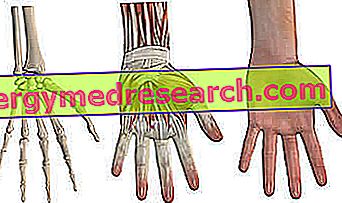Generality
The hand is the most distal end of each upper limb of the human body.
Equipped with 5 fingers, it has a rather complex structure, which includes numerous bones, joints, ligaments, muscles and tendons. Furthermore, it has a fine innervation and a complex network of blood vessels.

The most common problems that can affect the hand are bone fractures.
What is the hand
The hand is the distal end of each upper limb of the human body.
Start at wrist level and end with five fingers: thumb, forefinger, middle finger, ring finger and little finger.
Anatomical meaning of proximal and distal
Proximal and distal are two terms with opposite meaning.
Proximal means "closer to the center of the body" or "closer to the point of origin". Referring to the femur, for example, it indicates the portion of this bone closest to the trunk.
Distal, on the other hand, means "farther from the center of the body" or "farther from the point of origin. Referred (always to the femur), for example, it indicates the portion of this bone furthest from the trunk (and closer to the knee joint).
Anatomy
The hand is a complex structure, which includes numerous bones, joints, ligaments, muscles and tendons.
Before proceeding with the description of these components, it is good to specify the meaning of two terms: palm and back of the hand.
The palm of the hand is the ventral (or front) region of the hand, the one towards which the fingers converge when the fist is made. Making a comparison with the foot, it corresponds to the sole of the foot.
The back of the hand, on the other hand, is the back region of the hand, located on the opposite side of the palm. On the back side, the fingers end with the nails, corneal productions of the epidermis consisting mainly of keratin.
SKELETON OF THE HAND: THE BONES
The skeleton of the hand consists of as many as 27 bones, which the anatomy experts - to simplify the study - divide into three categories or groups: the carpal bones, the metacarpal bones and the phalanges.
- Carpal bones or carpal group or carpus . They form the anatomical region of the wrist and are in all 8 irregularly shaped bony elements, arranged in two rows: one proximal, close to the bones of the arm (ulna and radius), and a distal one, bordering on the base of the metacarpal bones.
The bones of the proximal row are the scaphoid, the lunate, the triquatum and the pisiform. Scafoide and semilunar are particularly important, because they are articulated with the radium forming, with the latter, the articulation of the wrist .
The bones of the distal row are the trapezoid, the trapezoid, the capitate and the unconditioned. While trapezoid, trapezoid and capitate are articulated each with the base of a metacarpal bone only, the unbleached joins two adjacent metacarpal bones. To be precise, the trapezoid borders on the metacarpus which then gives rise to the thumb; the trapezoid articulates with the metacarpus of the index; the capitate is at the base of the metacarpus of the middle; finally, the unbleached makes contact with the metacarpus of ring and little finger.
- The metacarpal or metacarpal bones or, more simply, the metacarpals . Belonging to the category of long bones, they are altogether 5 elements.
In each metacarpus, three portions can be distinguished: a central one, known as the body; a proximal one, called base; finally, a distal, which takes the name of head.
Each side of the body has a concavity, which serves as an insertion point for the interosseous muscles.
The base is the portion that borders the carpal bones and with which it forms joints.
The head is the region that makes contact with the first phalanx of the fingers: each metacarpal corresponds to a finger, therefore each metacarpal head is in association with the first phalanx of each finger of the hand.
- The phalanges . There are a total of 14 and represent (as it was possible to understand from a previous affirmation) the bony elements constituting the fingers of the hand.
Except the thumb - the only one formed by 2 phalanges - all the other fingers have 3 phalanges each.
The phalanges closest to the head of the metacarpus (proximal phalanges) are called first phalanges; starting from these, the following are called second phalanges and third phalanges (NB: in the case of the thumb, the numbering ends with the second phalanges).
| Table. Metacarpus numbering and fingers. |
| I metacarpus (the most lateral) → inch |
II metacarpus → index |
III metacarpus → average |
IV metacarpus → annular |
V metacarpus (the most medial) → little finger |
By convention, the lateral region of the hand is on the side of the thumb, while the medial region is on the side of the little finger. This presupposes that the point of view of the hand is with the palm facing the observer.
According to this convention, the most lateral metacarpus is the metacarpus corresponding to the thumb, while the most medial metacarpus is the metacarpus which borders on the phalanxes of the little finger.

Figure: The nutritious vessels and the nourishing hole in the long bones.
HAND JOINTS
To simplify the description of the numerous joints of the hand, it was considered appropriate to divide them by bone sectors: the joints of the carpal bones, the joints of the metacarpal bones and the joints of the phalanges of the hand.
At the carpus level, they are relevant:
- The wrist joint, also called the radiocarpal joint . It is a very complex joint element, which allows the movements of flexion, extension, circling, radial deviation and ulnar deviation.
- Intercarpal joints . The joints are located between the various carpal bones and allow the latter a certain degree of mobility. They contribute to the stability of the wrist.
- Carpal-metacarpal joints . They are the articular elements located between the carpal bones of the distal row and the corresponding metacarpals. They are not particularly mobile joints, but their presence is essential to provide stability to the wrist.
At the metacarpal level, the joints linking the head of each metacarpal to the proximal end of each phalanx are located.
These joints are called metacarpophalangeal joints .
Finally, at the phalanx level, the joints that connect the phalanges to each other stand out, namely:
- The joint that joins the first phalanx to the second phalanx, also known as the proximal interphalangeal joint .
- The joint that binds the second phalanx to the third phalanx, whose specific name is distal phalangeal joint .
This joint element is absent only in the thumb, where there is no third phalanx.
HAND TIES
A ligament is a formation of fibrous connective tissue, which connects two bones or two parts of the same bone.

Figure: flexion, extension, circumduction, radial deviation and ulnar deviation of the wrist joint.
In the area between the wrist joint and the carpus bones (intercarpal zone), the most relevant ligaments are: the radioulnar ligament, the dorsal radio-carpal ligament, the proximal intercarpal ligaments (interosseous, palmar and dorsal) and the distal intercarpal ligaments (interosseous, palmar and dorsal).
Between carpus and metacarpus, the most important ligaments are: the carpometacarpal ligaments and the intermetacarpal ligaments (interosseous, palmar and dorsal).
Finally, to conclude this brief overview of hand ligaments, the piso-uncinate ligament and the piso-metacarpal ligament deserve special mention. The first goes from the pisiform bone to the hook-shaped process of the hamate bone; the second runs from the pisiform bone to the anterior surface (palmar) of the V metacarpus (ie the metacarpus that precedes the phalanxes of the little finger).
| Table. What bones connect the most important ligaments of the hand? | |
| Ligament | Bones involved |
Radio-ulnar ligament | Radio and ulna |
Dorsal radio-carpal ligament | Radio and dorsal carpus |
Proximal intercarpal ligaments | Bone elements of the carpus located near the ulna and radius |
Distal intercarpal ligaments | Bone elements of the carpus located distant from ulna and radius |
Carpal-metacarpal ligaments | Carpal bones and metacarpals |
Intermetacarpal ligaments | Metacarpal bones |
HAND MUSCLES
The good functionality of the hand depends on muscles that reside totally in the hand and on muscles that localize in the forearm, but that, at the same time, with a part of them (the so-called tendons), connect to the skeleton of the hand.
The anatomists identify the muscles present entirely in the hand with the wording of intrinsic muscles, while they name the muscles located mainly in the forearm with the term extrinsic muscles .
For a more accurate analysis and a better understanding of all the most important muscle elements involved in hand movements, it is good to start from the group of extrinsic muscles and treat the intrinsic muscle group only later.
There are two categories of extrinsic muscles: the extrinsic extensors, which serve to stretch the hand and straighten the fingers, and the extrinsic flexors, which allow the closure of the hand.
- Extrinsic extenders
- Short radial extensor of the carpus. It is the main extender of the wrist; it is inserted at the base of the third metacarpal.
- Long radial extensor of the carpus. It's another extender of the wrist; it is inserted at the base of the second metacarpal.
- Carpal ulnar extensor. He is the third and last extender of the wrist; ends at the base of the fifth metacarpal.
- Common extender of fingers. It ends at the base of the second phalanges, in a central position, and at the base of the distal phalanges, in a lateral position.
- Extender of the index. It ends at the base of the second phalanx (of the index), in a central position, and at the base of the distal phalanx (always of the index), in a lateral position.
- Extender precisely of the minimum finger (ie the little finger). It ends at the base of the second phalanx (of the little finger), in a central position, and at the base of the distal phalanx (always of the little finger), in a lateral position.
- Long thumb abductor. It contributes to the extension of the thumb and ends at the base of the metacarpus corresponding to this finger of the hand.
- Short extender of the thumb. It contributes to the extension of the thumb and ends at the base of the proximal phalanx.
- Long thumb extender. It contributes to the extension of the thumb and ends at the base of the distal phalanx.
- Extrinsic flexors
- Carpal radial flexor. It is the main flexor of the wrist; it is inserted at the base of the third metacarpal.
- Ulnar carpus flexor. It's another flexor of the wrist; ends at the base of the fifth metacarpal.
- Long palm. It is the third and last flexor of the wrist; it is inserted at the level of the palmar band (a layer of very resistant fibrous tissue, located on the palm of the hand).
A curiosity: this muscle is absent in 15% of the population.
- Hand finger flexors. I am 8 in all and are divided into superficial and deep. The superficial ends at the base of the second phalanges; the deep ones, instead, end at the base of the third phalanges.
Moving on to the intrinsic muscles, these consist of 4 groups: the muscles of the eminence tenar, the muscles of the eminence hypotenar, the lumbrical muscles and the interosseous muscles.
- Muscles of the eminence tenar (or eminence tenar)
- Short abductor muscle of the thumb
- Short flexor muscle of the thumb
- Opposing muscle of the thumb
- Adductor muscle of the thumb
- Muscles of the hypotenar eminence (or eminence hypotenar)
- Short palmar muscle
- Abductor muscle of the minimum finger (ie the little finger)
- Flexor muscle of the minimum finger
- Opponent muscle of the minimum finger
- Lumbrical muscles . Originate where there are tendons of the deep flexors of the fingers of the hand (so they are on the fingers). They contribute to the flexion of the metacarpophalangeal joints and to the extension of the interphalangeal joints.
- Interosseous muscles
- Volatile interosseous muscles. They are 3 in all and contribute to the abduction movement of the fingers of the hand.
- Interosseous dorsal muscles. There are 4 in total and contribute to the adduction movement of the fingers of the hand.
Each of these muscles attaches to the hand bones by means of tendons .
A tendon is a formation, structurally, very similar to a ligament, with the only difference that it joins a muscle to a bone element.
To guarantee tendons of the hand a certain stability and to prevent possible malformations (for example, incurvamento), is a band of connective tissue, which is called retinaculum .
innervation
There are three nerves that supply the skin and hand muscles: the median nerve, the ulnar nerve and the radial nerve .
Each of these nerves has both a component of sensitive nerve fibers (connected to the skin) and a component of motor nerve fibers (connected to the skeletal muscles described above). Therefore, they are fully included in the category of mixed nerves .
They are derivations of the brachial plexus ; the brachial plexus is an important reticular formation of various spinal nerves (nerves of the peripheral nervous system ), which have the task of innervating the arm and precisely the hand.
The median nerve . With its motor branches (or branches), it innervates: all the extrinsic flexors, except the ulnar flexor of the carpus and the deep flexor of the middle finger and the little finger; all the muscular elements of the eminence of the tenar, except the adductor of the thumb and the short flexor of the thumb; the lumbricals of the index finger and middle finger.
The regulation of these muscular elements is at the base of the capacity known as precision grip of the hand.
With its sensitive branches, on the other hand, the median nerve controls the sensitivity of the thumb, forefinger, middle finger and ring finger, on its radial side (ie on the radial side).
The ulnar nerve . With its motor branches, it innervates: the flexor ulnar carpus muscle; the deep flexor muscle of the ring finger; the flexor muscle of the little finger; the adductor muscle of the thumb; the short flexor muscle of the thumb; all the muscles of the eminence hypotenar; the lumbrical muscles of the ring finger and the little finger; all interosseous muscles.
The control of this complex network of muscles is the basis of the capacity known as the power take-off of the hand.
With its sensitive branches, on the other hand, the ulnar nerve carries information from the brain to the brain: the hypinence eminence; the ulnar portion of the back of the hand; the little finger and the ring finger, on its ulnar side.
The radial nerve . Through its motor branches, it innervates all extrinsic extensor muscles and provides positional stability to the hand.
With its sensitive branches, on the other hand, information transposed to the brain from: the radial portion of the back of the hand; the dorsal region of the thumb; the dorsal region of the index finger; the dorsal region of the middle finger; part of the radial half of the ring finger.
BLOOD VESSELS
The hand has a complex network of arterial and venous blood vessels, which provide blood circulation in all its tissues (including muscles, ligaments, etc.).
The system of arteries is particularly articulated and deserves a description, albeit brief.
Blood supplies come from two fairly large arterial vessels, known as the radial artery and the ulnar artery . The latter, in turn, are derivations of a very important blood vessel, which is called the brachial artery .
The brachial artery runs along the arm and represents the main vascular element of this anatomical region; it runs parallel to the branches of the brachial plexus and separates into the radial artery and ulnar artery at the level of the elbow.
Functions
The hand has several functions, some of which have already been mentioned previously:
- Allows you to grab objects . Accuracy is when an individual holds an object by using his thumb and another or another two fingers; the thumb performs an abduction movement, while the other or other fingers involved perform a flexing movement. In the precision grip, the palmar surfaces of the fingers used "look at each other".
The power takeover, however, is when an individual grabs an object using all the fingers and the palm of the hand; the thumb, as well as the palm, serve above all to give stability to the handle. In the grip, there is almost total involvement of the hand muscles.
- It acts as a tactile sense organ . The skin sensitivity of the hand is used to determine whether an object is hot or cold; if it is rough or smooth; etc. Indeed, in some cases, the perception of heat, emanated for example by a radiator, can occur without direct contact.
- It is a communication tool . Hand language can effectively replace words. A very trivial example is the greeting with the hand; a more sought after example is the so-called "sign language", to communicate with deaf mutes: in these situations, the hand becomes a real communicative tool.
- Ensures stability for children who still walk on all fours .
Diseases of the Hand
The most common problems that can affect the hand are the fractures of the bones that constitute it, in this case: the fracture of the carpal bones, the fracture of the metacarpal bones and the fracture of the phalanges .
FRACTURE OF THE BONE CARPALS
The two carpal bones that usually undergo a fracture are the scaphoid and the lunate. Characterized by pain, the rupture is, almost always, subsequent to falls in which the victim of the event held his extended hand.
The scaphoid is, by far, the bone of the hand that fractures more often. If the fracture alters the blood supply to the scaphoid, it no longer receives the correct blood supply and undergoes a process of osteonecrosis (or avascular necrosis ).
Inadequate treatment of scaphoid fractures can lead to arthritis of the wrist.
Semi-lunar bone fractures are often associated with damage to the median nerve.
METACARPO FRACTURE
The metacarpals that most commonly undergo a fracture are the I metacarpus (precisely the base) and the V metacarpus (to be precise, the region that precedes the head and which the doctors call the neck).
Given the enormous spread of these two types of break, doctors have considered it appropriate to give them a particular name:
- Bennett 's fracture is the fracture at the base of I metacarpus . Subsequent usually to a hyperabduction of the thumb, it often also affects the carpal-metacarpal joint (obviously of the thumb).
- The boxer 's fracture is the fracture at the neck of the V metacarpus. It owes its particular name to the fact that it often affects those who punch against objects of a certain resistance (NB: it is typical of boxers).
FRACTURE OF THE FALANGES
Fractures of one or more phalanges are conditions of slight gravity, which arise as a result of traumatic events that damage the hand (for example, the crushing of a finger). They heal with just rest.



